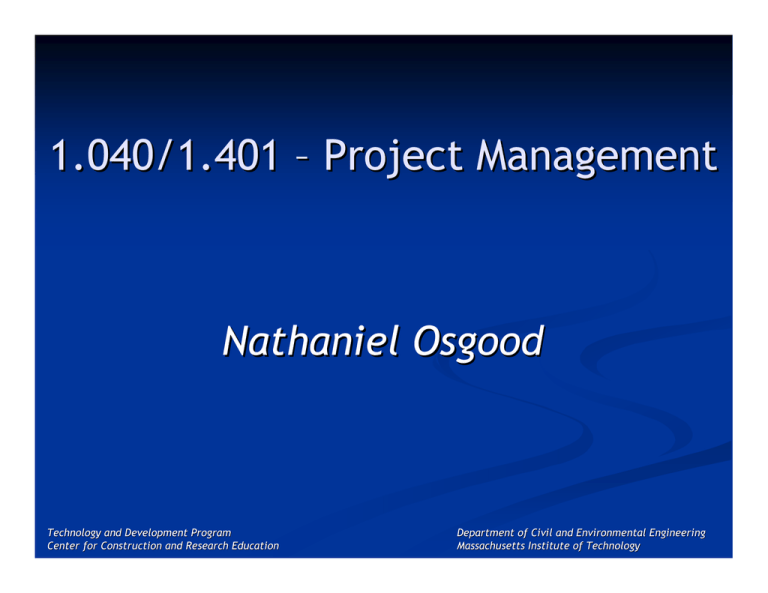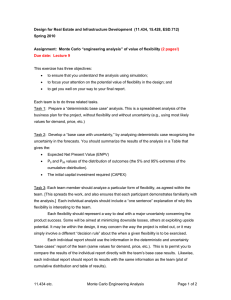1.040/1.401 – Project Management Nathaniel Osgood
advertisement

1.040/1.401 – Project Management Nathaniel Osgood Technology and Development Program Center for Construction and Research Education Department of Civil and Environmental Engineering Massachusetts Institute of Technology Outline Class Objective Course Information Context Lecture Outlines Mission Objective Inform professionals in the art and science of directing and coordinating human, equipment, material, and financial resources to develop a project in a way that they could give maximum attention to project details in the most costeffective way possible while maintaining a broad perspective of the project. Enhance the following attributes of these outstanding professionals: Technical skills. Communication skills. Decision-making skills. Problem-solving skills. Interpersonal skills. Leadership skills. Outline 9 Class Objective Course Information Context Lecture Outlines Mission Handouts Syllabus Handout: Course Description Course Organization Academic Honesty Survey (Problem set 1) Term Project Part I (TP1)c Class Schedule Monday & Wednesday (Osgood) Lecture 1:00 PM – 2:30 PM Friday (Grimaldi) Focused on Contractor practices Interactive discussion Recitation 3:00 PM – 4:00 PM Office Hours: TF,12-1pm (Osgood) Guest Lectures Dr. Oddmund Granli Megaproject organization Megaproject control Bill Fitzgerald (Behavioral components) Dr. Roberto Pietroforte (Façade scheduling) Victoria Siriani David Myers MIT Capital Planning Office MIT Facilities Management Prof. Fred Moavenzadeh Analytic & Qualitative Components Analytic: Lectures, readings, problem sets Tools for managing complexity, uncertainty Presented so Understand assumptions Understand shortcomings Anticipate future directions in construction Qualitative: Recitations, readings, problem sets Empirical components Understanding of current state of practice Reference Textbooks Primary Readers: System & Project Management, PeñaMora, Anumba, Lyneis, Soibelman, Samii, Park, Kalligeros. To be published in 2003 by Prentice Hall/MIT textbooks Construction Project Management. Hendrickson & Au. General introduction http://www.ce.cmu.edu/pmbook/ Quantitative components Construction Nightmares. Vignettes illustrating principles from course. Grading Individual Participation 15% Term Project / Individual Grading 50% Assignments / Individual Grading 35% Grading Details Late Assignments: Reduced 10%/day (compounded) up to 7 Days Group Term Project Evaluated Individually For Individual Assignments: Share with others ONLY Concepts and Problems Academic Honesty Statement Collaboration Large Group Group Dynamics Task Assignment Academic Honesty Individual Work Only Allows for Group Discussion of Concepts and Problems Do Not Copy Previous Year Work Reference Any Source When Confused Ask Instructor Term Project TP 1: Project Selection or Assignment TP 2: Estimating, Bidding, Mobilization Plan and Project Organization TP 3: Project Planning, Monitoring and Control TP 4: Claim, Close-Out, and Project Learning Deliverable: A Full Report and Presentation Iterative Process Software Packages Primavera P3 for deterministic time and resource scheduling Primavera Monte Carlo for probabilistic time and resource scheduling TreeAge for decision and risk analysis Vensim for system dynamics analysis Outline 9 Class Objective 9 Course Information ¾ Context Lecture Outlines Mission Project Management: An Iterative Process Evaluate Organize Learn Control Plan Monitor Project Scope Time /Schedule Cost/Budget Natural environment Political/social environment Quality Industry Context 1 Multiple Disciplines Unique and Evolving Project Team Generally One-of-a-kind Projects High Social/Political/Env. Implications Increasing sophistication of designs High Time pressure Cost and cost pressure (low profit) Complexity Uncertainty/Risk (cost, schedule, quality) Turnover Conflict & Litigation (claims 1% of cost) Industry Context II Important industry Construction value >$850B Roughly 8% of US GDP 700K construction firms Buildings are 70-80% of market Sectors 90%<10 employees 215K GC/Building, 442K trade contractors Residential const Commercial Industrial contractors Infastructure and heavy construction Affiliated institutions Professional services Suppliers Financial Services Uncertainty in Construction Uncertainty in Final Project Cost I Uncertainty in Final Project Cost II Uncertainty in Final Project Cost III A calamitous history of cost overrun Spectacular Projects with Spectacular Cost Overruns PROJECT Suez Canal Sydney Opera House Concorde Supersonic Aeroplane Panama Canal Brooklyn Bridge COST OVERRUN (%) 1,900 1,400 1,100 200 100 Sources: Peter Hall, 'Great Planning Disasters Revisited', p. 3; Robert Summers, 'Cost Estimates as Predictors of Actual Costs: A Statistical Study of Military Developments', in Thomas Marschak et al., eds., Strategy for R&D: Studies in the Microeconomics of Development (Berlin: Springer-Verlag, 1967), p. 148; and Mette K. Skamris, 'Economic Appraisal of Large-Scale Transport Infrastructure Investments', Ph.D dissertation (Aalborg: Aalborg University, 2000). Growing Expenditures, Declining Control Recurrent Themes Complexity Performance ($, time, quality) Uncertainty and Risk Flexibility Incentive Conflict Crucial role of qualitative and quantitative factors Parties –Diverse Motivations Owner Designer (Architects & Engineers) Role: Commissions project, arranges financing Common Motives: Good design, save $, finish quickly Role: Designs facility (typically w/owner) Frequently oversees construction Common Motives: Recognition, happy client Contractor(s) Role: Builds facility (often w/design assistance) Common Motives: Make $, finish quickly, happy client Survey of Construction Phases & Class Topics Survey of Construction Phases & Class Topics Feasibility Studies and Preliminaries Understanding project finance and evaluation Understanding and managing risk Helps understand economic challenges faced by owner and contractor Insight into risk premiums, incentives, making choices under uncertainty, management Deciding on fundamentals of contract Delivery type (organizational method) Award method (how decide who hired?) Contract type (how pay?) Conditions Project Evaluation and Financing Financing mechanisms Public, private and hybrid funding Time value of money, present value, discounted cash flow analysis Evaluation measures (NPV, IRR, Cost-benefit and cost-effectiveness analysis) MARR and WACC Risk Analysis Risk Management Basics of Decision Analysis Identification, Classification, Mitigation Decision Trees Risk attitude Essential concepts of preferences Sources of risk in construction Particular emphasis: Changes and Claims Example Decision Tree Accepted 6.75M 6750000<LowestCompetingBid Rejected 6750000>=LowestCompetingBid Accepted 7M 7000000<LowestCompetingBid Rejected BidPrice 7000000>=LowestCompetingBid Accepted 7.25M 7250000<LowestCompetingBid Rejected 7250000>=LowestCompetingBid Accepted 7.5M 7500000<LowestCompetingBid Rejected 7500000>=LowestCompetingBid 6750000-Costs 0 7000000-Costs 0 7250000-Costs 0 7500000-Costs 0 Delivery, Award, Contract Method Delivery Methods – How to organize? Award Mechanism – How to pick? Lowest cost, Multiparameter, Negotiated Contract Type – How to Pay? DBB, DB, Turnkey, BOT, Mult. Primes,... Lump sum, Cost plus %, GMP, etc. Contract Design Scope definition Risk sharing Dispute resolution Pointers to avoid claims, defend contract Survey of Construction Phases & Class Topics Design Phase A/E and owner Define scope, budget, time of project Estimation Initial Planning Successive estimates produced Deterministic Probabilistic Resource Possible roles for contractor Value Engineering (Flexibility considerations) Constructibility Analysis Project Estimating Project Budgeting Life-Cycle Costing Successive estimates Preliminary (financing) model Schematic, development, contract Methodologies Parametric Quantity Takeoff Deterministic and Probabilistic Estimation Deterministic Planning I Critical for Careful examination of approach Juggling diverse activities, resources Reasoning on cost, time at completion Monitoring & Control Use in litigation Phased and fast-tracked construction Gantt (Bar) Chart Network Techniques CPM PDM Criticality Index Criticality Splitting Warnings Tips to watch out for Probabilistic Planning PERT Monte Carlo Simulation GERT Q-GERT Dynamic Planning Methodology Resource Planning Budget Management Resource Scheduling People, Space, Equipment, Materials,… Resource-Cost Tradeoffs I Line-of-Balance Method Quality assurance Survey of Construction Phases & Class Topics Project Monitoring Performance Categories Earned Value Approach Progress Reporting Learning effects Cost and Schedule Monitoring Reviews and audits Project Control Cost/time tradeoffs Acceleration Resource shifting Project crashing Feedbacks complicating control Managing changes and risks Claims and Changes Control Principles to limit damage Conflict escalation Dispute resolution On-call contractors Delay claims Dynamics of claims and claim resolution Project Control Feedbacks Dynamics of Changes, Rework Quality Cost Time Counter-intuitive effects of acceleration Overtime lowers quality, productivity Fast track increases sensitivity & vulnerability Example Feedbacks Survey of Construction Phases & Class Topics Project Close Out Substantial and final completion Termination Close Out Warrantees Outline 9 Class Objective 9 Course Information 9 Context 9 Lecture ¾ Mission Outlines Mission Statement “The mission is to help organizations achieve their project objectives and objectives of scope, quality, budget, and schedule within the context of the natural, social and political environment in which the project is being developed.”






